
Rules flouted at Yala National Park
Many Safari Jeep drivers operating inside the Yala National Park are openly flouting regulations put in place by authorities to ensure the safety of animals and tourists.
Drivers, eager to please tourists, increasingly engage in rec klesss behaviour that not only harass the animals, but also putting the lives of tourists at risk.
We observed several such incidents including driving vehicles at high speed, taking the jeeps off designated pathways, climbing atop vehicles and the obstruction of animals.
Authorities imposed strict regulations, including speed limits on vehicles inside the sanctuary after a leopard was killed by a speeding vehicle on August 28. 2015.
However recently many safari jeep drivers, have been flouting the regulations.
While less than 125 safari jeeps were in operation during the war years, today over 700 jeeps operate in the same area.
The lack of a proper mechanism to regulate the entry of jeeps entering the reservation has created further problems, including traffic jams, inside the park.
Officials also say most jeeps operate in only one section of the park despite the park being divided into five sections.
Director General of the Department of Wildlife Conservation (DWC), W.H.D. Pathirathna said there were plans to divide the Yala forest into three separate sections and restrict entry of vehicles to only one section. He added however, this would take time as it required a large investment.
In the meantime, authorities have stepped up patrols inside the park to locate and ban jeeps which flout park regulations.

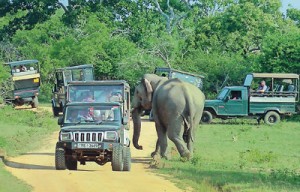
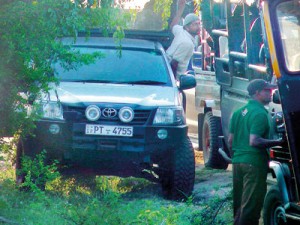
Source – 05/03/2017 , The Sunday Times ,See more at – http://www.sundaytimes.lk/170305/news/rules-flouted-at-yala-national-park-231524.html
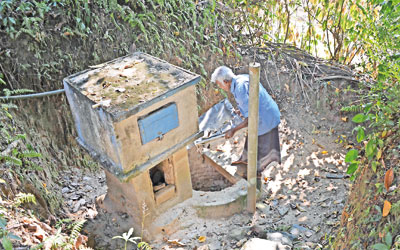
Despite nationwide drought disaster, no emergency
An elderly resident in Hemmathagama, Aranayake looks down a well that has run dry. Pix by Saman Wijeya Bandara
By Anushiya Sathisraja
In twenty three out of the 25 districts of Sri Lanka, people are crying out for water, farmlands are parched and indebted farmers are facing long-term financial ruin. The country’s economy will weaken by a percentage point, an international rating agency has warned, while also noting that the debt-laden island’s fiscal deficit target will not be met.
More than a million people are suffering, especially in the main rice-growing districts including Anuradhapura, Polonnaruwa and Kurunegala.
But the island will not declare a state of emergency because the tourism industry could be affected, Disaster Management Minister, Anura Priyadharshana Yapa, told the Sunday Times, adding that relief programmes are continuing, he said.
“5,000 water tanks and 250 tractor mounted bowsers have been requested by the ministry. The Disaster Management Center has ordered 50 tractor mounted bowsers separately, which have been already distributed to Gampaha and Kurunegala districts. We plan to distribute others shortly,’’ he said.
To avert food shortages, 250,000 metric tonnes of rice are being imported, he said.
Colombo will not face a water shortage because of the high levels of water in the Kelani River, but he warned that sea water is flowing into the river.
A report by the UN Food and Agriculture Organization says 15 per cent of the rice harvest will be lost this year. The overall paddy harvest is likely to be lowest for three years and vegetable prices have increased sharply in the past three months.
Professor Anthony Norbet of the Colombo University’s Department of Geography said efforts should be made to improve the people’s ability to cope with the effects of the drought. He suggests cultivating crops such as kurakkan that requires less water.
Subsistence paddy farmers who depend on minor irrigation, make up the majority of people hit by the drought.
Gradually declining rainfall over the last four years in combination with the lower Maha and Yala harvest of recent years, have left them progressively poorer.
Despite intermittent rains last week, 18 districts are badly affected and worse, including food shortages, are feared.
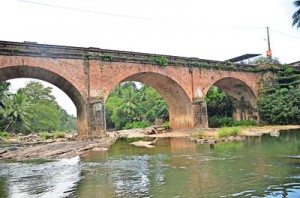
Disaster Management Centre figures reveal that 303,000 families comprising more than a million people are experiencing an acute water shortage. The Northern Province is the hardest-hit with 411,796 people suffering.
All districts in the North, Vavuniya, Mullaitivu, Mannar, Killinochchi and Jaffna are experiencing the severe dry spell; with the most affected being the Jaffna district’s Delft (4,586), Kayts (3,553), Maradankulam Karainagar (10,500), Telippalai (10,172), Chavakachcheri (24,024) and Chankanai (7,445) areas.
The second largest number of people affected are in the Western Province 407,600, while 67,442 are affected in Minuwanagoda. In Divulapitiya, and Katana 61,140 and 27,051 are suffering, respectively.
Sri Lanka relies heavily on seasonal monsoon rains for water. And as a result of poor monsoons over the past two years as well as weak rainfall in the early months of this year, reservoirs, ponds and wells have dried up.
Studies suggest that while there have been alternate dry and wet spells over the past three decades, the frequency of drought years has been increasing.
Weather experts also say there is a need for further study to address this issue since the South Asian region is set to face severe drought spells for the next three decades.
The constant cooling of the atmosphere over Central Asia has been cited as one of the main reasons for frequent drought years in the country, Lalith Chandrapala, the director general of the Department of Meteorology said.
Due to the atmospheric disturbance in the vicinity of Sri Lanka showery conditions are expected to continue during next few days, particularly today.
Cloudy skies along with showers or thundershowers can be expected at times over Eastern, Northern North Central and Uva provinces and Hambantota district. Showers or thundershowers will occur elsewhere particularly after 2.00pm.
Fairly heavy showers (of about 75 mm) are also likely at some places. There may be temporary localised strong winds during thundershowers.
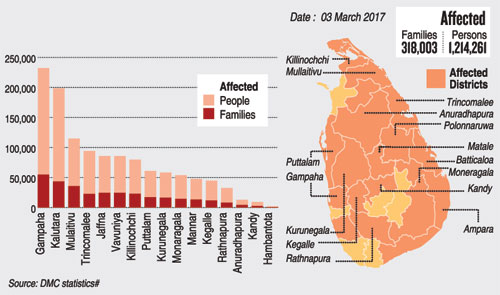
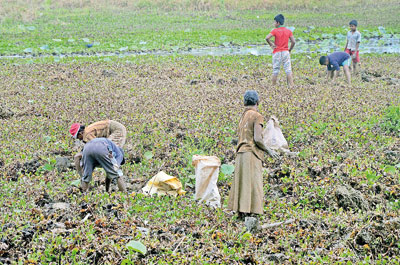
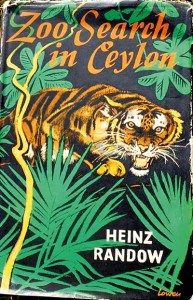
From a transit compound for animals to the birth of our zoo
The fact that the Zoo exists is due to the curiosity of Europeans in the 19th century about the animals of tropical lands that they read about in explorers’ and colonisers’ accounts. Elephants, leopards, crocodiles, dragons … all sounded so incredible, they had to be seen to be believed. As some pioneer animal collectors discovered, there was money to be made in capturing wild animals in the tropics and sending them to Europe where people would pay to see them on display.
Sri Lanka became Europe’s source of animals for zoos and circuses as a result of the efforts of two men, both German. This country was actually the leader in the conservation of natural resources, regarding them as assets. The world’s first fauna and flora sanctuary was established at Mihintale in the 3rd century BC by King Devanampiyatissa (250-210 BC).
In modern times, the opening of National Parks at Yala in a protected area of 979 sq km and Wilpattu with an area of 1,316 sq km in February 1938 was a conscious effort to protect the many species, especially elephants and leopards, living within them. Up to then, jungle animals were considered as “game” to be shot, not as food but as trophies. The government-run National Zoological Gardens had been opened to the public two years earlier to give people a chance to see wild animals in a mock jungle habitat; to marvel at them just as people did at zoos in Europe.
However, the opening of the Zoo was not a deliberate plan of the government. It happened because of the bankruptcy of the private company that created and owned a depot in Dehiwala where wild animals from Sri Lanka, and in transit from India and East Asia to Europe, were caged.
The capture and collecting of wild animals in a professional way was begun in the island colony at the beginning of the last century by a settler from Germany, John Hagenbeck (1866-1940). He was the half-brother of Carl Hagenbeck (1844-1913) who became famous in Europe as an animal dealer and zoo creator.
John and Carl were the sons of Gotfried Claes Carl Hagenbeck (1810-1887), who was a fishmonger in Germany with a part time business in buying and selling exotic animals. John settled in Ceylon in 1891 when he was 25, attracted – like many Europeans – to the island by the profits to be made from being a tea planter.However, he was persuaded by his brother Carl to capture animals in Ceylon and ship them to him in Germany.
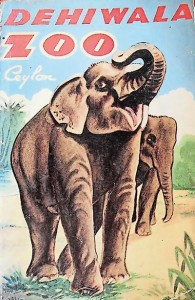
He did so enthusiastically sending an early shipment of wild animals that included 67 Ceylon elephants. This enabled Carl to start the world’s first open-plan zoo at Stellingen, near Hamburg in 1907. Following the success of this, other countries wanted animals and John Hagenbeck obliged, finding a plentiful supply in this country where wild animals were considered an annoying impediment to the progress of colonisation. He also arranged to import animals from other countries and in the 1920s established a transit compound on 11 acres of land he bought in what was then jungle wilderness near Dehiwala.His success resulted in the start of various Hagenbeck circuses and zoos around the world, as well as being the beginning of the National Zoological Gardens.
The second German enters the scene then in the shape of a forgotten pioneer, a German zoologist called Heinz Randow. His activities only came to light when he wrote a book, published in English in 1958, about his adventures in this country 35 years before. It is an astonishing, as well as entertaining book called Zoo Search in Ceylon. It was published with a dramatic cover showing a snarling tiger.
Not much is known about Heinz Randow, apart from what he cares to reveal in his book which defines him as fearless in his pursuit and care of wild animals, while appreciating the luck that saved him many times from being killed by beasts, snakes or scorpions. The remarkable composure shown by the author in trying circumstances is evident from the book’s beginning, when he states: “John Hagenbeck picked me out of the crowd of passengers leaving the ship, drove me by car from Colombo in a southerly direction towards Dehiwala.
“The plan was to set up there a collecting station for animals and later, perhaps, even a zoo…Beyond Wellawatte we went across broken country through coconut groves and areca estates into the bush. After driving through a small Sinhalese village we drew up in a large compound by a lake, on whose shores crocodiles were basking in the sun. On our right was a bungalow which looked as if it had been built in early pioneer days. Close by I saw some light, airy structures roofed with palm leaves, in the shelter of which were cages with tigers and leopards. In the shade of a coconut grove work-elephants dozed in their chains.”
Hagenbeck took Randow to the bungalow. “He indicated the cluster of natives who stood there gaping at us, [and said] ‘Pick yourself a boy to act as your personal servant from this crowd. [You must] get to know Sinhala and Tamil, the two native languages.’ Then he gave me a loaf of bread and half a pound of butter and drove back to Colombo.”
Randow’s book is a fascinating account of how he settled in and survived for several years, building up a team of local hunters who captured animals to be exported for Hagenbeck’s enterprises, or to be put on display at the depot in Dehiwala. Randow also describes how he began clearing the area that was the beginning of today’s Zoo.
“Four leopards, four tigers, two black panthers, about two hundred monkeys of various kinds, and a few deer were housed in makeshift cages in the large compound. This flat area, teeming with lizards, snakes and other creatures, was still only partially developed, so I made it one of my most urgent jobs to build paths and footways through the wilderness of plants.
“After a few days everything was going smoothly. Each morning at seven o’clock a chattering crowd of natives stood in front of my bungalow, the men on the left, the women on the right. Tasks were allotted and work began. Paths were built, stretches of scrubland burnt, and sheds put up, in the shelter of which cages were to stand. One working-party fenced the land in with barbed wire, another built enclosures for deer and other animals and slowly everything took shape…At last the stage was reached at which the capture and purchase of animals could begin.”
The alert reader may wonder about the presence of tigers in Randow’s cages. They were there in transit as the compound was used as a base for gathering animals from around the region for eventual shipment to the Hagenbeck headquarters in Germany. Randow tells of how one day caged animals were to arrive by steamer from Bangkok for transhipment. When the ship anchored, Randow discovered that the man in charge of the animals had been taken ill with malaria and hadn’t fed or watered the animals for a few days. He writes: “My first duty, therefore, was to provide all the birds and mammals with fresh drinking water. When this had been done we attended to the malaria patient and had him taken to hospital.”
Fortunately the animals survived the journey and Randow recounts his animal residents were increased by several monkeys, as well as “ten black panthers, six almost fully grown tigers…” He also mentions a tiger sent from Madras as a cub “packed in a basket lined with banana leaves.”
He recalls that while transporting by ox cart from Colombo harbour crates containing ten Asiatic black bears that had arrived by steamer from Bombay, the convoy was attacked by a leopard as it approached Dehiwala. To save his life, Randow shot the animal dead. Usually he preferred to capture animals or to buy them from locals who caught them and brought them to his verandah. By his own account, he had dozens of cages of such a variety of animals, that the compound became an informal Zoo. Rendow hired a Eurasian who spoke English to act as guide to the tourists who began to visit the Zoo.
In a review of the book published in the Chicago Sunday Tribune in 1958, Randow is described as “a German zoologist” with the comment that “some of the outstanding denizens of European zoos were collected by Randow.” This overlooks his informal foundation of the Dehiwala Zoo by collecting so many creatures, from tiny turtles to hulking elephants, and creating an amenable environment where they could be viewed by the curious.
Randow eventually returned to Germany and the company created by John Hagenbeck called the Ceylon Zoological Gardens Company went bankrupt. It was saved by being taken over by the government and a superintendent put in charge. When it was made an autonomous department in 1946, the main aim was to satisfy people’s curiosity and thus the Zoo was more focused on entertainment rather than conservation.
In his foreword to the 1957 guide, “Dehiwela Zoo, Ceylon” the then Minister of Home Affairs, A. P. Jayasuriya, proudly claimed the zoo is “well in the forefront of the most beautiful zoos in the world.” The 168-page guide was compiled by the Zoo’s director, Major Aubrey N. Weinman, who wrote, “We rather have the predilection for a small friendly Zoo of about 40 acres…to display the animals to their best advantage…by giving them their natural environment as far a possible.”
Writing about the Zoo as it was 60 years ago, he states: “The Zoo can point with pride to well conditioned, healthy and happy looking animals; beautiful and colourful settings abounding in brilliant foliage and flowers; absolute cleanliness and absence of odour.” A photograph of the Zoo in the book makes it seem pastoral and idyllic.
As well as giving a description of the 2,000 animals then in the Zoo, Weinman adds fascinating notes about the daily diet of those animals, such as “A seven-foot elephant consumes a 1,000lb of food a day” and “A rattlesnake or cobra has a small rat once a week.” He lists the daily food requirements of the Zoo as including 90lb of bananas, 48 grasshoppers, 24 frogs, eight rats and 250lb of beef or horsemeat.
While today’s visitors to the Zoo have little idea of how it grew out of an independent animal-exporting depot in the wilderness, because of the extraordinary efforts of John Hagenbeck and Heinz Randow, they can enjoy seeing animals not just from Sri Lanka but from around the world.
Source – 05/03/2017,The Sunday Times, See more at – http://www.sundaytimes.lk/170305/plus/from-a-transit-compound-for-animals-to-the-birth-of-our-zoo-231149.html

Nochchiya solar village gets water and revenue
Solar roofs: Work in progress to install solar panels in the dry zone village of Nochchiya
The first stage of a large solar village project at Nochchiya village-cluster in the Kurunegala district has been completed, with the installation of two solar power systems funded by UK-registered charities – The Association of Professional Sri Lankans in the UK (APSL) and Hela Sarana.
The Hela-Sarana-funded system was dedicated in memory of Raja Meehitiya, founder President of Hela Sarana who passed away in June 2015.
Nochchiya will be the second large village cluster to benefit from the solar village concept in Sri Lanka, the first being Kaduruwewa in the Kurunegala district, where the concept was launched in 2008.
The solar village project concept was designed and developed by Prof. I.M. Dharmadasa, in the late 1990s to empower rural communities using clean energy technologies for sustainable development and poverty reduction. Poverty reduction programmes in any community should have two main features; wealth creation methods and follow-up methods for job creation within the community.
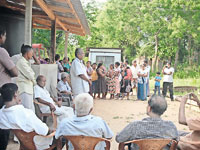
Community spirit: Nochchiya villagers hold a meeting to mark the completion of the first phase of the project
Two solar roofs of 3 KW each were installed in the village with the funding provided by the two charities. The cost of each system was Rs. 830,000 (£4.500). The power produced from 6 KW solar roofs will be fed into the national grid, and the income generated will be used to cover the cost of two water pumping stations that would be operated using grid electricity. The revenue will be managed in a fully transparent way by the Village Development Committee with guidance from project initiators. The project team will monitor the performance of the two solar roofs.
The water pumped and purified is mainly used for drinking by more than 1200 people in this village thereby preventing any kidney or water related diseases. The purified water is also available to seven surrounding villages. They can buy it at a nominal price. The project team within the APSL-UK is guiding the community to achieve rapid economic development applying the solar village concepts.
The project also fulfils 13 of the 17 SDGs (Sustainable Development Goals) of the United Nations, and is also highly relevant to Sri Lanka as it supports the Government’s recently launched “Soorya Bala Sangramaya” (Battle for Solar Energy) programme.
Source – 05 /03/ 2017 , The Sunday Times, See more at – http://www.sundaytimes.lk/170305/sunday-times-2/nochchiya-solar-village-gets-water-and-revenue-231497.html
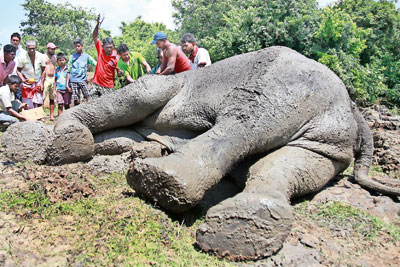
Deadly garbage dumps pose elephantine problems
By Malaka Rodrigo
Agonising death: The elephant which died after suffering for more than a month after eating garbage at Manampitiya. Pic by Karunaratne Gamage
An elephant which had been regularly eating garbage at Manampitiya died last Saturday after suffering from a sickness for a month.
This well grown male, about 20 years of age, was part of a herd that fed on garbage from a dump at Manampitiya. It had fallen ill in the third week of January. A veterinary surgeon and a team of wildlife officers tried to flush out any non-digestive materials from its stomach. One even inserted a hand through its anus to manually pull anything that remained. At first they pulled out about 15 kilograms of polythene in a day and over a month about 30 kilograms were removed.
Dr Pramuditha Devasurendra who had treated the elephant, rejected the idea that the polythene was the cause of death. He said toxic bacteria in rotting food may have been the cause. “The garbage pit contains lots of lunch sheets with rotten food. Deadly bacteria can grow on the food. This is main reason for the death of the elephant.”
Dr Devasurendra revealed that a post-mortem did not find any polythene in the bowels of the dead elephant. Its liver and spleen were damaged.
He said he had treated another elephant about half a kilometre away from the garbage dump at Manampitiya. “That elephant too died and I have been unfortunate to witness deaths of at least 10 elephants since I assumed duties in this area four years ago,” Dr Devasurendra said.
The Manampitiya dump is not the only one that attracts elephants. A garbage dump in Dambulla attracts elephants. Yet another dump in Hambantota is protected by an electric fence.
Dr. Devasurendra said an electric fence was needed at Manampitiya.
Meanwhile, Dr Prithiviraj Fernando, estimates that there are at least 50 locations where elephants come to forage at the dump. They are mostly in the dry zone.
Dr Fernando said piles of vegetables, over ripe fruit, flour, rice, bread and the like are more nutritious than what is found naturally. Elephants which rummage for these at the dumps are in better health, he said.
But he said every day 500 elephants may be eating garbage. “In a year, how many of them would die as a result? How does this compare with other ‘unnatural’ causes of elephant deaths? Such as being shot, hakka patas, injuries from trap guns and nooses, train or vehicle accidents, starving to death inside parks after being driven in and restricted with electric fences,” he asks.
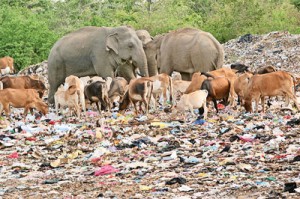
This also means the elephants are not raiding farms. So if they are to be prevented from raiding garbage dumps would it increase the human elephant conflict, and how many of them would be injured and killed? And how many people would be injured and killed? Dr Fernando asks.
“So before jumping in and trying to ‘fix’ something one should first find out what the problem is, figure out the cost and benefit of ‘fixing’ and make an informed decision. Otherwise the cure may be worse than the disease,” he warns.
Dr. Fernando suggests separating the organic matter from the plastics, metals, and glass materials before being dumped.
Source – 05/03/2017 ,The Sunday Times , See more at – http://www.sundaytimes.lk/170305/news/deadly-garbage-dumps-pose-elephantine-problems-231517.html
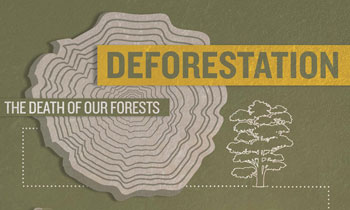
Deforestation in SL decreased by 0.4 per cent in past decade: UN
According to the report issued by the Food and Agriculture Organization (FAO) of the United Nations, deforestation in Sri Lanka has decreased to 0.4 per cent during the past decade, Conservator General of Forests Anura Sathurusinghe said yesterday.
Mr. Sathurusinghe told the Daily Mirror that the FAO report, issued every five years, has rated Sri Lanka as a country with less deforestation during the period of years 2000 – 2010. “During the past decade (2000-2010), the deforestation in the country has decreased to 58, 791 hectares of forest land, which was rated as 1.3 per cent as against 104, 380 hectares during the period 1990 – 2000. At present the FAO has rated Sri Lanka as a country with minimum forest cover,” he said.
Meanwhile, he said they had decided to launch an web portal to detect the places where deforestation was prevalent around the country. “The website will be launched in the coming month. Any person who has information of deforestation taking place in their areas can inform us so that we can investigate it,” he said, adding this would help immeasurably to control deforestation in the country. (Kalathma Jayawardhane) –
Source – 03/03/2017 ,Daily mirror ,See more at: http://www.dailymirror.lk/article/Deforestation-in-SL-decreased-by-per-cent-in-past-decade-UN-124891.html#sthash.ftdFkKYF.dpuf









